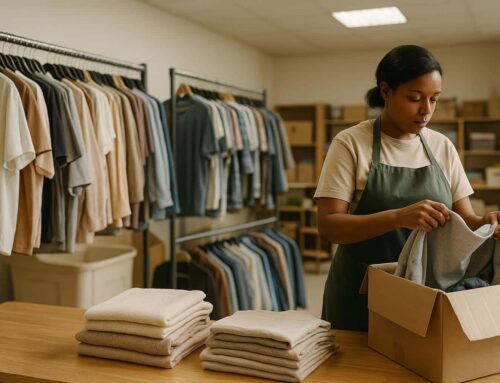Thrift stores are a simple way to cut waste and help the environment. Here’s how they make an impact:
- Textile Recycling: Unsellable clothes are turned into new materials instead of going to landfills.
- Furniture Repair: Old furniture is refurbished and resold, reducing the 12 million tons of annual furniture waste.
- Electronics Resale: Broken gadgets are repaired and sold, keeping e-waste out of landfills.
- Clothing Swaps: Community events encourage reusing clothes, cutting fast fashion waste.
- Donations to Schools/Artists: Unsold items are given to schools and artists for creative projects.
- Recycling Partnerships: Collaboration with recycling centers ensures even damaged items are repurposed.
- Move-Out Programs: Colleges and housing areas donate usable items during move-outs.
- Waste-to-Energy: Unusable textiles are converted into energy, reducing landfill waste.
- Vintage Preservation: High-quality vintage items are resold, promoting reuse over new production.
- Workshops: Repair and upcycling workshops teach waste reduction skills.
Thrift stores like Kansas City’s City Thrift not only reduce waste but also support local communities by funding charitable programs and creating jobs. Every donation or purchase helps cut down on waste and promotes a circular economy.
1. Textile Recycling Programs
When clothing and textiles can’t be resold, recycling programs step in to give these items a second life. These programs repurpose unsellable items through specialized processes, turning what might have been waste into something useful.
Here’s a staggering fact: Americans produce 16 million tons of textile waste every year, with 85% of it ending up in landfills. To tackle this issue, thrift stores collaborate with textile recyclers and salvage brokers. Items too damaged or worn for resale are sorted by material type and color, then sent to facilities where they’re transformed into new fibers. Natural fibers find new uses in products like furniture cushions and insulation, while synthetic materials are processed into polyester chips, which are melted and spun into fresh fibers.
This recycling effort doesn’t just reduce waste – it also saves money and creates jobs. For every ton of textiles recycled, disposal costs drop by about $45. Plus, the process generates employment opportunities in areas like collection, sorting, processing, and manufacturing.
A great example of this approach is City Thrift. In the Kansas City area, they ensure that every donated item that can’t be sold is diverted from the landfill. Thanks to partnerships with recycling organizations, even worn-out and damaged textiles are put to good use. These efforts not only reduce waste but also support community programs like those run by City Union Mission. It’s a win-win for the environment and the local community.
This kind of initiative highlights how waste can be transformed into valuable resources, paving the way for more creative upcycling solutions.
2. Furniture Repair and Refurbishing
Every year, around 12 million tons of furniture waste is generated in the U.S., with a staggering 80% of it ending up in landfills. Repairing and refurbishing furniture not only brings new life to old pieces but also plays a crucial role in cutting down this waste.
The refurbishing process is highly personalized, depending on the type of furniture. For solid wood items, the first step often involves sanding away scratches or stains. Once the surface is smooth, a fresh finish is applied to restore the piece’s original charm. Painted furniture is prepped and updated with new colors, while upholstered items might get a deep steam cleaning or even brand-new seat covers.
“Simple tools and techniques can transform worn furniture.” – MERS Goodwill
The results can be stunning. Take, for example, Thirty Eighth Street’s 2017 project: they purchased two damaged nightstands from Goodwill for $25 each. After repairs, repainting, and refinishing, the nightstands were completely transformed into beautiful, functional pieces.
City Thrift in Kansas City takes this approach seriously. Their skilled team, including volunteers, works on restoring everything from dining room tables to bedroom furniture. Minor scratches are smoothed out, deeper gouges are filled with wood filler and refinished, and even heavily damaged upholstered pieces are steam-cleaned or reupholstered as needed.
This method benefits everyone. Customers get access to affordable, one-of-a-kind pieces while helping to reduce waste. Unlike cheaply made furniture, which often lasts only about five years, these restored items are built to endure. Plus, every piece saved from the landfill conserves resources and contributes to a cleaner environment.
3. Electronics Repair and Resale
Did you know that each person in the U.S. generates about 8 kilograms of e-waste every year? Despite this staggering amount, only 17% of it gets recycled. Globally, e-waste is expected to surpass 74 million tons by 2030.
Much like refurbished furniture and clothing, electronics can have a second life through repair and resale. Thrift stores play a key role in this process by collecting functional electronics, ranging from computers to smartphones, and refurbishing them for resale. Some stores even have specific guidelines, such as not accepting televisions older than five years.
In the last fiscal year, The Salvation Army Thrift Store successfully diverted over 10.7 million pounds of electronic and metal waste from landfills.
“But we’re also always looking to spread awareness about what we do, and to find new ways to prevent items from going to landfill. It’s an all-in-one system that helps people and helps the earth.” – Dan Kinsey, The Salvation Army Thrift Store’s distribution and recycling director for Canada
The refurbished electronics market is booming. In 2022, it generated $55.6 billion, with estimates reaching $120 billion by 2026. Stores like City Thrift contribute to this growth by accepting donated devices, extending their lifespans, and helping reduce waste. Their efforts also make technology more accessible for families on tight budgets.
Repairing electronics doesn’t just help the environment – it also saves consumers money. Fixing devices saves Americans up to $40 billion annually. By offering refurbished products, thrift stores provide an affordable alternative that encourages more sustainable consumption.
If you’re shopping for refurbished electronics, it’s a good idea to test the devices and check the store’s return policy beforehand, as many items are sold “as-is.”
4. Community Clothing Swap Events
Community clothing swaps are a simple, effective way to tackle textile waste. In the U.S., a staggering 66% of unwanted clothing and textiles end up in landfills. These events offer an easy solution: participants bring clothes they no longer wear and exchange them for “new-to-you” items. This local exchange keeps clothing in circulation, encouraging reuse and creating a small-scale circular economy for fashion. Beyond reducing waste, these swaps help strengthen community bonds and pave the way for organized, impactful events.
“Clothing swaps offer a sustainable and impactful climate solution by promoting circular fashion. They reduce the demand for new clothing production, minimizing the carbon footprint associated with manufacturing and transportation.” – Commons Team
Thrift stores, such as City Thrift, can play a big role in hosting these events, extending their mission beyond their storefronts. Planning typically begins 2–3 weeks in advance and includes details like securing a venue, setting a guest list, and establishing quality guidelines for the items. For smaller gatherings of 8–15 people, a simple one-for-one swap system works well. Larger events with 20 or more participants often benefit from a token system, where the quality of items brought determines how many tokens participants receive to “spend” on other items. This thoughtful organization enhances both the sustainability impact and the sense of community.
The environmental benefits are undeniable. Swapping clothes reduces the demand for new garments, which in turn lowers the fashion industry’s carbon footprint. Fast fashion alone accounts for up to 10% of global greenhouse gas emissions, so every piece swapped instead of purchased makes a difference. These events also encourage mindful consumption and provide a cost-effective way to refresh wardrobes. Themed swaps – like those focused on vintage pieces or children’s clothing – are becoming increasingly popular, showing how these events can be tailored to fit the unique interests of a community.
“Swap before you shop – save money and reduce waste.” – Blue Mountains Parents for Climate group
For thrift stores, hosting clothing swaps is a win-win. It’s a chance to connect with the community while furthering their waste reduction goals. Any leftover items that aren’t swapped can be donated back to the store, supporting their inventory and mission.
5. Material Donations to Schools and Artists
Expanding on recycling and repair initiatives, donating materials offers a practical way to reduce waste while supporting education and creativity. Unsold items find new life in the hands of schools and local artists, fueling projects that inspire learning and artistic expression, all while keeping usable materials out of landfills.
Take Art From Scrap in Santa Barbara, for instance. This organization turns a variety of donations into discounted bulk supplies for educators, making creative resources more accessible. Similarly, centers like Remainders Creative Reuse and the Child Creativity Lab repurpose donated art and craft materials into essential classroom supplies and STEAM kits, offering tools for hands-on learning and innovation. The impact is measurable: Upcycle Parts Shop in Cleveland, for example, has diverted 37 tons (74,000 pounds) of waste from landfills over seven years through its reuse efforts.
In Kansas City, City Thrift follows a similar path by channeling unsold goods into community programs. As Repurpose Rising explains:
“We transform donated art and craft supplies into tools for creativity and sustainability. Our mission is to empower individuals and foster environmental stewardship through creative reuse. Join us in turning discarded materials into opportunities for innovation and community connection.”
This approach is about more than just reducing waste. Donations like these provide schools and local artists with essential resources, removing financial hurdles that might otherwise limit creativity. They help students develop practical skills, encourage innovative thinking, and build stronger connections within communities through education and the arts. City Thrift reinforces this mission by distributing unsold items to schools, art studios, and workshops throughout Kansas City, pushing the boundaries of what creative reuse can achieve.
6. Partnerships with Local Recycling Centers
Thrift stores are stepping up their efforts to manage unsold donations by teaming up with local recycling centers. These collaborations ensure even the most worn-out items are handled responsibly, avoiding landfills and finding alternative uses. This approach not only extends the life of donated goods but also strengthens the positive impact on the community.
Here’s a staggering fact: Americans produce 16 million tons of textile waste every year. Of that, over 3 million tons are incinerated, and about 10 million tons end up in landfills. For thrift stores, recycling partnerships are a game-changer when donations can’t be sold. Some programs have successfully diverted over 42,000 tons of textile waste from landfills annually. On a smaller scale, regional efforts have turned nearly 14,645 pounds of unsellable textiles into industrial cleaning rags, all while creating job training opportunities.
The recycling process itself is quite detailed. Items are sorted by material and color. Natural textiles are cleaned and carded, while synthetic fibers are transformed into polyester chips for new products. Impressively, 95% of clothing and textiles can be reused or repurposed in some way. In certain regions, these efforts have kept over 103 million pounds of textiles from clogging up landfills.
This problem isn’t just national – it’s local, too. For example, in Kansas City, City Thrift partners with recycling facilities to ensure unsold items help reduce waste. These efforts mirror the successful strategies seen in other areas. And it doesn’t stop with textiles – some programs focus on electronics recycling, allowing residents to donate old computers, which are then responsibly recycled within the U.S..
7. Move-Out Collection Programs
The move-out season at universities and housing communities often creates a surge in waste as students and residents discard items they can’t store or transport. Many of these items are still perfectly usable, and thrift stores have stepped in to help by organizing collection programs. These initiatives not only cut down on waste but also turn discarded goods into resources that benefit the community.
Take George Washington University‘s Green Move-Out program, for example. In May 2024, they collected a staggering 41,250 pounds of goods – 23,000 pounds of clothing and 16,000 pounds of household items. These were distributed to the community through 12 partner organizations.
Similar efforts are underway at Georgia Tech and UCLA, where programs gather items like cups, mini-fridges, clothing, and blankets. These goods find new life in campus closets, food pantries, animal shelters, or are even used for upcoming semesters.
Some programs go a step further by adopting a circular economy model. UCLA’s Sustainable Move Out program, for instance, stores mini-fridges on campus during the summer and redistributes them to students in the fall. This approach ensures that items are reused by multiple students over several years. To encourage participation, UCLA also offers incentive systems like vouchers for thrift sales held in the fall.
At Cal Poly, the CP Thrift program demonstrates just how impactful these efforts can be. In its first year, the program collected over 1,500 reusable items, weighing 3,280 pounds. Impressively, 96% of these goods were redistributed to the Cal Poly community during their fall thrift fair.
“We created Eco Exit. A lot of people don’t have the storage and it’s just so much more convenient to throw it out than to store it or transport it or, um, like give it away.” – Ali Taliaferro, Second-year student at University San Diego
The success of these programs hinges on well-organized volunteer efforts, partnerships with local organizations, and strategically placed donation bins in residence halls.
In Kansas City, City Thrift sees the potential for similar collaborations with universities and housing communities. By teaming up during peak move-out periods, they could collect high-quality donations while significantly reducing local waste streams.
8. Textile Waste-to-Energy Programs
When textiles in thrift stores have reached the end of their usable life, they don’t have to be destined for landfills. Textile waste-to-energy programs provide a smart solution by turning donations that can’t be resold into electricity. This approach not only reduces waste but also generates cleaner power for local communities.
Here’s how it works: unsellable textiles are converted into fuel, which is then used to heat water and produce steam. That steam drives turbines, creating electricity. This process can reduce landfill waste by up to 90%. By giving a second purpose to items that can’t be recycled or reused, these programs complement recycling efforts and contribute to a more sustainable system.
The scope of the textile waste issue makes these initiatives particularly important. Annually, $197.14 million worth of clothing ends up in landfills. In 2018 alone, U.S. landfills received 11.3 million tons of textile waste, with only 14.7% of all textiles being recycled. Since textiles can take over 200 years to break down in landfills, converting them into energy offers a far better alternative.
Researchers at Kaunas University of Technology and the Lithuanian Energy Institute have been exploring ways to tackle even the smallest forms of textile waste. In June 2021, they developed a pilot pyrolysis plant designed to convert microfiber lint from clothes dryers into energy.
“I believe that the collection system, similar to deposit-return for drink containers, could be developed based on our research. A household would bring the lint-microfiber from their drying machine filters to a collection point and receive some kind of compensation for it”, explained Dr. Samy Yousef, senior researcher at Kaunas University of Technology.
Large-scale waste-to-energy plants further showcase the potential of this technology. These facilities can power thousands of households while significantly reducing CO₂ emissions.
Thrift stores can play a vital role by partnering with waste-to-energy facilities to repurpose their unsellable textiles. Items that are too damaged, stained, or worn for resale become valuable energy sources instead of contributing to landfill waste. This creates a more circular economy, ensuring even the most deteriorated donations have a purpose.
A great example is City Thrift in Kansas City. Recognizing the value of waste-to-energy programs, City Thrift collaborates with these facilities to manage textiles that can’t be sold or donated elsewhere. Through such partnerships, thrift stores can expand their waste reduction efforts while also helping to power local communities.
9. Vintage Item Preservation
Thrift stores play a crucial role in preserving vintage items, giving them a second life while reducing waste. By extending the lifespan of these timeless pieces, thrift stores help counter the fast fashion cycle and its environmental impact.
These stores offer a broad selection of clothing from various decades, styles, and backgrounds, keeping well-crafted, high-quality items out of landfills and reducing the demand for new production. This variety highlights the importance of durable, long-lasting quality over fleeting trends.
Vintage items are often made with superior craftsmanship and materials, meaning they last longer and require fewer replacements. This durability not only reduces waste but also minimizes the environmental strain across the entire supply chain. For instance, opting for second-hand clothing can cut carbon emissions by an average of 25%.
As Sarah Davis, president and founder of Fashionphile, notes:
“Buying fewer quality items is better than buying a lot of cheaper, low-quality things, and resale helps more people to have access to even more high-quality pieces that will be around for decades, not years”.
Preserving vintage items also supports a circular economy, where resources remain in use rather than ending up as waste. Shockingly, 87% of the fiber used in clothing ends up incinerated or in landfills. By embracing second-hand shopping, we can help change that narrative.
Thrifting has grown in popularity, with high-end designers, celebrities, and influencers showcasing their thrifted finds. Younger generations, in particular, are drawn to vintage pieces for their distinctive style and eco-friendly benefits.
Take City Thrift as an example. This thrift store carefully curates vintage clothing, furniture, and household items, highlighting decades of quality craftsmanship. Through their efforts, they contribute to reducing the over 11 million tons of textile waste generated annually in the United States. Every vintage item sold prevents it from adding to the staggering 92 million tons of textiles sent to landfills each year. By keeping these resources in circulation, City Thrift demonstrates how preservation can align with sustainable practices.
10. Workshops on Waste Reduction
Thrift stores across the country are stepping up as hosts for hands-on waste reduction workshops. These sessions aim to inspire long-term changes in behavior, showing how diverse programs can contribute to larger sustainability efforts.
At the heart of these workshops are repair and upcycling sessions. For instance, a reuse center in Italy offers free classes to teach participants how to repair and creatively upcycle items. In Vienna, a repair voucher program has been a game-changer, slashing repair costs by 50% and helping fix over 22,000 items in its first year alone.
Closer to home, local programs are making a big impact. ABQ Sewing Studio‘s “Upcycling Green Style” program, Portland’s annual Fix-It Fair, and Austin’s regular Fix-It Clinics are just a few examples of initiatives teaching essential repair and upcycling skills. These workshops often explore themes like zero-waste living, plastic-free alternatives, and reducing food waste, giving participants the tools they need to adopt more sustainable habits.
Rebecca Child of London Repair Week shared the purpose behind their efforts:
“The aim [of London Repair Week] is to give Londoners practical skills and encourage greater use of existing repair services. This is done in the name of sustainability but what we really wanted was to scale up repair in London, and shine a spotlight on brilliant people in the community who are promoting repair.”
Community hubs like SCRAP take this mission further by collecting discarded materials and offering them for resale or donation, often to teachers and organizations. Similarly, Repurpose Rising in Des Moines, Iowa, organizes workshops focused on sustainable crafting and creative reuse techniques.
City Thrift also stands out in this movement, providing workshops that not only teach waste reduction skills but also support their broader mission of helping the homeless and those in need. Their efforts reduce waste and cut carbon emissions, all while fostering community engagement.
The benefits of these workshops go beyond individual learning. Youth-focused programs play a key role in teaching younger generations about sustainability. Altogether, these initiatives prove that thrift stores are evolving into more than just retail spaces – they’re becoming community hubs for sustainability. They empower people to reduce waste, save money, and strengthen local economies.
Conclusion
Thrift stores play an essential role in cutting down waste and fostering stronger, more connected communities. Through initiatives like textile recycling and hands-on workshops, they create a sustainable cycle that benefits everyone involved.
The numbers speak for themselves. Each item that finds a second life through thrifting means fewer resources wasted and a smaller environmental footprint. On top of that, thrift shopping saves consumers a significant amount of money – around $1,800 annually – while also boosting local economies by funding community initiatives and reducing the demand for new production.
What makes thrift stores so impactful is their accessibility. Whether you’re donating unused items, volunteering, or choosing to shop second-hand, every action contributes to reducing waste. These small, individual efforts collectively create a meaningful impact.
Organizations like City Thrift perfectly illustrate this. By reinvesting proceeds into community programs and keeping still-useful goods out of landfills, they demonstrate the broader benefits of thrifting. As City Thrift puts it:
“Thrift shopping helps you stretch that dollar further and nab imaginative finds, all while doing Mother Nature a solid by reducing waste. It puts money back into your pocket and keeps meaningful treasures out of landfills.”
Getting started is simple. Take a look through your home for items in good condition that you no longer need, volunteer at a local thrift store, or organize a donation drive to multiply your impact. The next time you need clothing, furniture, or household items, consider making your local thrift store your first stop. Every purchase supports community programs and helps cut down on waste from new production.
City Thrift reminds us that even small acts, like donating or shopping second-hand, can have a big impact over time. Thrift stores show us that sustainability and community support are deeply connected. By embracing the circular economy they represent, we can all help conserve resources, reduce waste, and strengthen our local communities – one second-hand treasure at a time.
FAQs
How do thrift stores help reduce textile waste, and what happens to donated clothing?
Thrift stores play an important role in cutting down on textile waste by giving unwanted clothing a new lease on life and recycling materials that can’t be sold. When you donate clothes, they go through a process that includes collection, sorting, and repurposing. Items that are still in good condition are resold, extending their usefulness and lessening the demand for new production.
For clothing that can’t be resold, recycling is often the next step. This process involves breaking the fabric down into fibers, removing components like zippers or buttons that can’t be reused, and turning the materials into products such as insulation or even new fabrics. By keeping textiles out of landfills and encouraging reuse, thrift stores help conserve resources and minimize waste.
How do thrift stores contribute to local communities beyond reducing waste, and what economic benefits do these efforts bring?
Thrift stores do much more for local communities than just cutting down on waste. They provide jobs, often giving people from underserved backgrounds a chance to work, which helps strengthen the local workforce and lowers unemployment rates. Plus, many thrift stores channel their profits back into community initiatives like education, job training, and homelessness support, creating a direct and positive impact on social welfare.
From an economic perspective, thrift stores operate within a circular economy. By reselling donated goods, they not only bring in revenue but also lower the demand for brand-new products. This approach encourages environmentally mindful shopping habits, boosts local economic activity, and nurtures a stronger sense of community involvement.
How do thrift stores support sustainable living and help reduce waste from fast fashion and electronics?
Thrift stores play an important role in encouraging sustainable living by giving a second life to clothing, electronics, and household items. By selling pre-owned goods, they help cut down on waste, save resources, and reduce the need for new production, a process that often requires large amounts of water and energy.
These stores also support a circular economy, where items are reused instead of discarded. For instance, buying second-hand clothing helps lessen the environmental toll of fast fashion, while opting for used electronics can reduce e-waste. Beyond helping the planet, thrift stores inspire people to make more conscious and eco-friendly decisions in their everyday lives.





